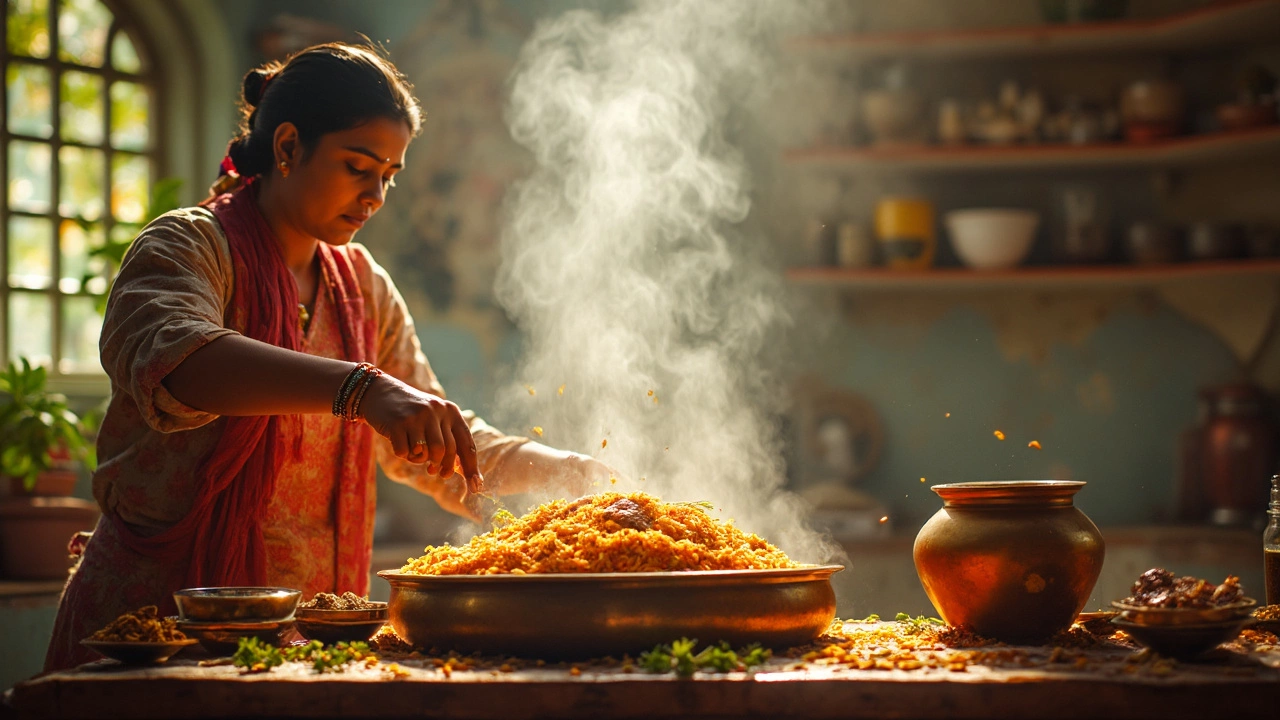What is the Secret of a Good Biryani?
 Jun, 4 2025
Jun, 4 2025
If you’ve ever wondered why some biryanis hit you with flavor and others fall flat, it usually comes down to a few key choices in the kitchen—not just the recipe, but how you put it together. There’s no such thing as a ‘one-size-fits-all’ secret. It’s all about getting the basics right: rice type, spices, meat, and how you build those layers.
Most people skip details like washing rice thoroughly (which stops it from going sticky) or don’t pay attention to the meat soaking up enough marinade. Even the smallest shortcuts show up in the final dish. Want that restaurant-style hit at home? You're going to need patience, bold spices, and some planning. But don’t worry, it’s not rocket science—just honest cooking and knowing a few tricks that actually work.
- All About the Rice
- Getting That Aroma Right
- Meat: Marination and Cooking
- Layering: The Real Game-Changer
All About the Rice
You can’t mess around with the rice in biryani. Seriously, if the rice is off, the whole thing falls apart. The absolute go-to for most biryani recipes is long-grain basmati rice. Why? It turns light and fluffy, not clumpy or mushy. The right basmati holds up to steam and spice—exactly what you want.
One weird but true fact: just soaking the rice before cooking makes a big difference. Ten to twenty minutes in cold water is usually enough. This helps the grains expand and stay separate, not stick together and get gummy.
Another must: rinse the rice well. I mean really rinse it, until the water’s basically clear. This flushes out the extra starch and avoids that hated sticky texture.
| Rice Type | Typical Grain Length | Best For |
|---|---|---|
| Basmati | 6-8 mm | Biryani, Pilaf |
| Jasmine | 5-7 mm | Thai Fried Rice |
| Sona Masoori | 4-5 mm | Everyday Indian Meals |
Here’s how to get the rice right for any biryani:
- Always soak and rinse before cooking.
- Use about 1.5 cups of water for every cup of rice when boiling; don’t drown it.
- Don’t overcook. Aim for “90% cooked”—still a bit firm when you take a grain and squeeze it.
- Drain it right away so it doesn’t keep cooking in leftover water.
The real trick is knowing the rice still has one more round in the pot—getting steamed with the rest of the biryani. That’s when it gets that final texture, so if you overdo it in the first step, you’re done for.
Getting That Aroma Right
If biryani had a signature move, it's definitely the burst of aroma that hits you as soon as the lid comes off. Getting this right isn’t an accident—there’s science (and a bit of tradition) behind it. It starts with the right spices. Whole spices like cloves, cardamom, cinnamon, and bay leaves are not just added for flavor, but for that heady scent they release when heated. Always go for whole spices over powders—just crushing them a little before adding lets out more oils and fragrance.
Saffron is another game-changer. Just a small pinch soaked in warm milk and drizzled over the top gives biryani a floral note and a golden color. It's pricier than other ingredients, but you only need a tiny bit. Fried onions, also called birista, do double duty—adding both sweetness and that typical biryani aroma. Don’t skimp and take time to fry onions until they’re truly crisp and brown.
Let’s talk about layering. When you add cooked rice on top of the meat and sprinkle in rose water or kewra water, you’re creating layers not just of flavor, but of scent. Don’t skip this step—just a spoon or two is enough for that real “wow” factor. If you want to see which finishes give the strongest aroma, check out the table below.
| Ingredient | Impact on Aroma | How Much To Use (for 1 kg rice) |
|---|---|---|
| Whole Spices | Strong | 1-2 each (clove, cardamom, cinnamon stick) |
| Saffron (in milk) | Very Strong | 10-12 strands in 2 tbsp milk |
| Fried Onions | Medium-Strong | 2-3 large onions, sliced & fried |
| Rose/Kewra Water | Mild but Distinct | 1-2 tbsp, sprinkled during layering |
One last thing—don’t lift the lid until it’s time to serve. Every time you open the pot, you lose those precious aromas. Use a tight lid or even seal the pot edges with dough to really trap the fragrance inside. It’s simple steps like these that make a biryani smell (and taste) just right.

Meat: Marination and Cooking
Getting the meat right in biryani isn’t just about tossing some chunks in with the rice and calling it a day. Marination does more than add flavor—it tenderizes the meat so every bite is juicy, not chewy. Most chefs swear by yogurt-based marinades, mixing it with ginger, garlic paste, fresh lemon juice, and those good old classic spices: cumin, garam masala, chili powder, and turmeric. Marinate for minimum two hours, but honestly, leaving it overnight in the fridge always gives the best results.
If you’re using chicken, about 2-3 hours will do, since it soaks up flavor pretty quick. For mutton or beef, plan for at least 6 hours of marination—there’s just no shortcut here. The acid (mainly from the yogurt and lemon) breaks down proteins, making the meat tender. And don’t forget salt in the marinade. It’s not just for taste—it helps lock in juiciness while cooking.
"If the meat isn’t marinated long enough, it won’t taste like biryani—it’ll just taste like rice with meat," says Chef Hussain Shahzad of The Bombay Canteen. "You need every fibre to soak that spice and tang."
Here’s how the marination process breaks down for different meats:
| Meat Type | Preferred Marinade Time | Common Marinade Add-ins |
|---|---|---|
| Chicken | 2-3 hours | Yogurt, ginger garlic paste, lemon, spices |
| Mutton | 6-8 hours | Yogurt, fried onions, garlic, warm spices |
| Beef | 8 hours or overnight | Yogurt, papaya/pineapple paste (for tenderness), spices |
Cooking technique matters just as much as marination. Most home cooks dump the meat and rice together, but there are two classic approaches: pakki biryani versus kacchi biryani. In pakki, the meat is cooked before being layered with rice, so you get consistent flavor but sometimes less juiciness. In kacchi, marinated raw meat is layered with half-cooked rice and then slow-cooked (on dum), locking all those juices in. This is riskier (if the meat’s not tender, it stays tough), but when it works, it’s magic—the flavors are intense and the meat melts apart.
The bottom line: don’t rush the marination, stick to the right marinade for your meat, and understand what method works best for your mood (and patience level). Good biryani rewards those who let the meat take its time.
Layering: The Real Game-Changer
This is where even regular cooks can make magic—or mess. Layering isn’t just stacking rice and meat on top of each other. When done right, every spoonful of biryani packs in bursts of flavor, not just bland patches of rice and unevenly cooked bits of meat.
The big trick is to layer half-cooked rice and cooked meat (or veggies for veg biryani) in a way that lets the spices, fat, and aromatics move up during steaming (also called dum). On average, a good home cook uses two to three layers, while restaurant biryanis might go for four or more—but more layers doesn’t always mean better taste. It's about how you build each layer.
- Biryani isn’t complete without ghee or fried onions in between layers. This helps with moisture and adds depth. Some folks add mint, coriander, or even a splash of saffron milk for that classic color and aroma.
- Never put all the meat together at the bottom, or you risk overcooking it. Start with a small layer of rice, then a layer of meat, then rice again, and repeat if you have enough for more rounds.
- Each layer should be lightly packed—not pressed down. Pressing ruins the grain and makes the biryani feel heavy instead of fluffy.
- Add a little hot water or stock around the edges before covering to help finish cooking the rice evenly.
Check out this basic layering breakdown:
| Step | What Happens |
|---|---|
| Bottom Layer | Thin rice layer protects meat from direct heat |
| Middle Layer | Cooked meat and a sprinkle of fried onions/spices |
| Top Layer | Rice, more fried onions, saffron milk, herbs |
| Finish | Seal and cook on low (dum) for 25-30 mins |
One rookie mistake: skipping the "dum" (sealed steaming) step. This is what lets flavors mingle and the rice finish cooking without drying out. Use a tight lid or even dough around the rim if you want to copy Grandmom’s fussiness—trust me, it matters.